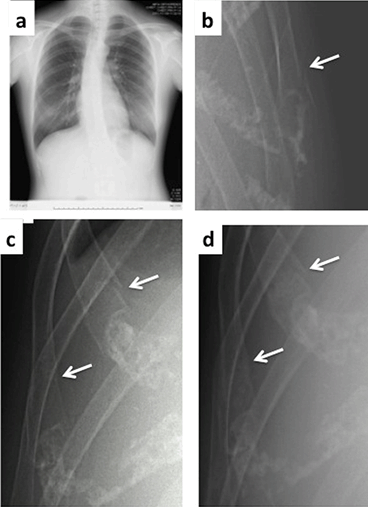Dear Editor
Applying manual uterine fundal pressure is a maneuver performed to shorten the second stage of labor1. This maneuver involves the application of manual pressure to the uppermost part of the uterus (uterine fundus) and directed towards the uterine axis. How often this maneuver is performed in routine obstetric practice is unclear; however, it is much more frequently performed in developing than developed countries1. For example, this maneuver was performed in 4% of all vaginal births between 1994 and 1995 in the Netherland2 but was 'prevalent' in rural central Bangladesh3. It has been established that the maneuver may cause adverse events for both mother and neonate1, and maternal rib fracture has been reported4. We hope to raise clinicians' index of concern for this issue by reporting a recent case from Japan.
Case report
A 34-year-old primiparous Japanese woman was admitted to hospital at term due to the onset of labor. Four hours after full dilatation of the cervix, the presenting fetal head had appeared in the introitus and she had performed the Valsalve maneuver without apparent difficulty. An obstetrician applied manual fundal pressure. With two fundal pressure maneuvers the woman gave birth to a healthy 3254 g infant.
After delivery the woman complained of chest pain. The attending doctor considered this was due to muscle pain from prolonged bearing down and an X-ray was not undertaken. The woman visited an orthopedist on the 9th postpartum day and an X-ray revealed fractures of the right 7th and 8th ribs, and the left 8th rib (Fig1a-c). A rib band was applied which relieved her pain. The woman accepted our apology for causing rib fractures and gave us consent to report her case.

Figure 1: Findings of the rib X-ray. (a) On the 9th postpartum day: no pneumothorax or hemothorax is observed
(rib fractures are not identifiable at this magnification). (b) The same day, at higher magnification, a fracture at the left 8th rib (arrow)
is observed. (c) The same day, fractures at the right 7th (upper arrow) and 8th rib (lower arrow) are evident. (d) On the 30th postpartum day the rib fractures are healing
(upper and lower arrows indicate the fractured right 7th and 8th rib fractures, respectively).
Discussion
A Cochrane systematic review concluded: 'There is no evidence available to conclude on benefit or harmful effects of manual fundal pressure'1. However, although the frequency of this maneuver has not been determined, it is still used - especially in rural and remote areas where performing cesarean section delivery or using vacuum extraction may be difficult. An unreliable supply of electricity may prevent clinicians performing vacuum extractions even in urban areas. Temporary disruptions to the supply of electric power were experienced recently in Japan after the Great East Japan Earthquake, and this prevented the use of vacuum extraction, although only for a short period. Thus, although the wellbeing of mothers and their babies cannot be predicted after applying uterine fundal pressure, in some circumstances obstetricians or midwives may be obliged to perform this maneuver.
Postpartum chest pain may be attributed to muscle pain caused by bearing down during delivery, and postpartum women sometimes complain of pain in the lower thoracic region. In such cases, a diagnosis of rib fractures due to the application of fundal pressure may not have been considered. In others, diagnosed rib fractures may have not been reported for medico-legal reasons, and this has been suggested in the literature4. The present authors agree that some cases of rib fractures are either unrecognized or unreported.
Clinicians must be aware that rib fractures can occur as a result of the manual fundal pressure maneuver, and because of this it is recommended that pressure is applied towards the uterine axis. Direct pressure to the rib cage must be avoided. Chest pain after the use of this maneuver can be a sign of rib fractures and an immediate X-ray should be performed to make the diagnosis. Because this maneuver is performed more frequently in rural remote area, the caution advised here must be applied by healthcare professionals managing rural and remote medicine/obstetrics for the benefit of the women and babies in their care.
Shigeki Matsubara MD, PhD1, Fujio Mita MD, PhD2
Ichiro Kikkawa MD, PhD3 & Mitsuaki Suzuki MD, PhD1
1Departments of Obstetrics and Gynecology & 3Pediatric Orthopedics
Jichi Medical University, 2Mita Orthopedic Clinic
Tochigi, Japan
References
1. Verheijen EC, Raven JH, Hofmeyr GJ. Fundal pressure during the second stage of labour. Cochrane Database Systematic Review 2009; CD006067.
2. de Leeuw JW, Vierhout ME, Struijk PC, Auwerda HJ, Bac DJ, Wallenburg HC. Anal sphincter damage after vaginal delivery: relationship of anal endosonography and manometry to anorectal complaints. Disease of Colon and Rectum 2002; 45(8): 1004-1010.
3. Goodburn EA, Gazi R, Chowdhury M. Beliefs and practices regarding delivery and postpartum maternal morbidity in rural Bangladesh. Studies in Family Planning 1995; 26(1): 22-32.
4. Kouritas VK, Baloyiannis I, Desimonas N, Daponte A, Kouvaraki M, Hatzitheofilou K. Rib fractures with heamothorax after labor: a case report. Cases Journal 2009; 2: 8950.

